South and About! Spring 2021
April 19
South & About! is a student-organized research workshop on the arts from Latin America and the Caribbean. This program invites graduate students and emerging scholars in art history and related disciplines to participate in informal discussions amongst their peers.
To register for the online event, please write to, fif204@nyu.edu
The Counter-Baroque: Transhistorical Expressions in Contemporary Latin American Art
Sara Garzón, PhD Candidate, History of Art and Visual Studies, Cornell University
In the past three decades, we have seen an increasing interest among Latin American artists to appropriate the sensibilities of the Baroque period. However, what in the past has been called the Neobaroque in reference to hybrid and syncretic models, after the 1990s shifted into what I would like to term a “counter-Baroque” aesthetic. Using the works of Ecuadorian artist María José Argenzio (b. 1973, Guayaquil), I will discuss how, beyond a Baroque form, these contemporary artistic expressions demonstrate a critical engagement with a Baroque ethos. Enacted through tropes of excess, artifice, and theatricality, the Baroque ethos, while nascent in the sixteenth century, perdures today through the continuation of plantation optics, the performance of social stratification, and the theater of the body. Since Baroque culture combines the religious visual regimes that were cemented during the period of Spanish colonial rule with the disciplining optics of the colonial administration, the counter-Baroque aesthetic that I am interested in tracing incorporates an explicit critique of Baroque visuality, as this has been complicit with colonialism.
Stitching Worlds: Mourning and Solidarity through Collaborative Embroidery
Chloë Courtney, PhD Student, History of Art, The Institute of Fine Arts, New York University
In 2011, Mexican conceptual artist Teresa Margolles began a series of collaborative embroideries worked on cloths stained with the bodily fluids of murder victims. While Margolles has long confronted viewers with visceral evidence of systemic violence, this series of embroideries operates differently. Each project activates a community of participants who bring their own knowledge, experience, and trauma into conversation with the instance of violence the stained cloth represents. Further, participants respond to the material traces of this violence through the craft of needlework, honoring the victim through visual strategies particularly suited to embroidery.
Recent scholarship has examined how Margolles’s use of textiles manifests emotional labor, affect, and care in response to ongoing violence. In this paper, I further this discourse by attending to the specific textile knowledge and iconography of the embroidery Margolles created in collaboration with a Maya women’s advocacy group in Santa Catarina Palopó, Sololá, Guatemala. Drawing from decolonial theory, I trace how its cartographic iconography connects contemporary femicide with the hemispheric impacts of coloniality. Finally, I attend to the complex associations tied to craft in the Americas, and how the craft status of the embroideries nuance their function as vehicles for testimony and memorial.

78 ¾ x 78 ¾ inches
Embroidery on fabric previously stained with blood from the body of a woman assassinated in Guatemala City. Created with the participation of Mayan women members of the Asociación de Desarrollo de la Mujer K’ak’a Na’ (ADEMKAN): Bonifacia Cocom, Lucy López, Yuri López, Silvia Menchú, Claudia Nimacachi, Lucrecia Puac, Estela Tax, and Josefina Tuy.
February 8
South & About! is a student-organized research workshop on the arts from Latin America and the Caribbean. This program invites graduate students and emerging scholars in art history and related disciplines to participate in informal discussions amongst their peers.
To register for the online event, please write to, fif204@nyu.edu
Miquael Williams, MA Student, History of Art and Archaeology, Institute of Fine Arts, New York University



